Latin America Video Surveillance Market Size
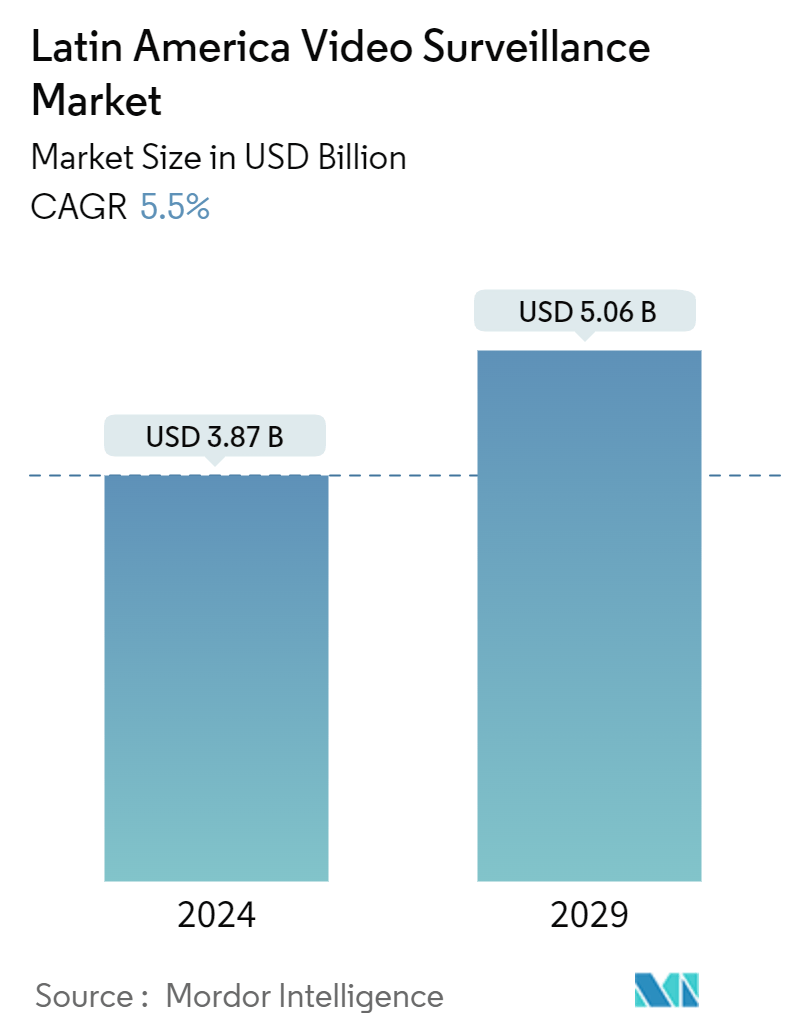
| Study Period | 2019 - 2029 |
| Base Year For Estimation | 2023 |
| Market Size (2024) | USD 3.87 Billion |
| Market Size (2029) | USD 5.06 Billion |
| CAGR (2024 - 2029) | 5.50 % |
| Market Concentration | Low |
Major Players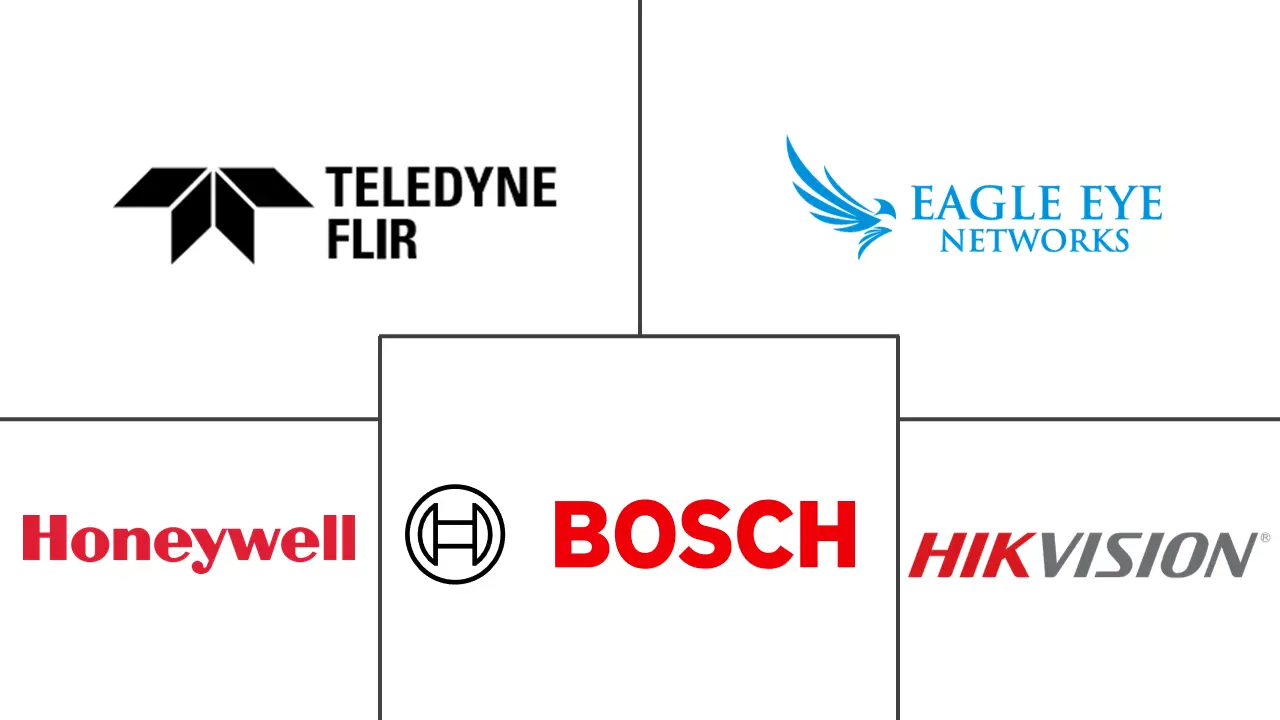
*Disclaimer: Major Players sorted in no particular order |
Latin America Video Surveillance Market Analysis
The Latin America Video Surveillance Market size is estimated at USD 3.87 billion in 2024, and is expected to reach USD 5.06 billion by 2029, growing at a CAGR of 5.5% during the forecast period (2024-2029).
- Video surveillance systems capture images and videos inside or outside of an establishment that can be stored or sent over related communication networks to be analyzed for security purposes. These systems/solutions can be used in nearly any environment, becoming an essential infrastructural requirement for all organizations globally to maintain specific security and monitoring measures. As a result, recent years have witnessed a dramatic increase in demand for security applications such as video surveillance to monitor and record corporate houses, borders, transportation infrastructure, and other public and private institutions/infrastructures.
- Considering the evolving dynamics of the Latin American market, video surveillance systems are significantly growing in demand. According to the Population Reference Bureau, Latin America is highly urbanized. As of 2023, about 82% of the population in Latin America lived in urban areas.
- As population concentration in urban areas is usually high, it often leads to several issues, such as growth in crime rates, which require advanced solutions to increase the sense of security among citizens. Also, video surveillance systems help authorities analyze/track if people are following the rules such as traffic rules. In recent years, governments have taken initiatives across several Latin American countries to improve law and order, driving opportunities in the market.
- The development of smart cities is one of the key initiatives driving the demand for video surveillance solutions in Latin America. Several Latin American countries have become a part of this initiative and have launched innovative city projects across their respective countries. For instance, in February 2024, newly elected members of several Colombian cities visited Korea to advance their understanding of smart city initiatives started by Seoul, enhance partnerships with the private sector, and foster connections with local governments.
- Also, a higher crime rate across several Latin American countries is another major factor encouraging law enforcement authorities to invest in advanced security and surveillance systems. As video surveillance is considered among the most effective solutions to curb unlawful activities, such trends will also support the market's growth in the region.
- However, the higher cost of advanced video surveillance systems, such as IP-based, AI-based, or hybrid security cameras, continues to remain among the major factors challenging the market's growth in Latin America as the region has a relatively lower economic growth compared to developed or other developing regions such as Asia-Pacific.
Latin America Video Surveillance Market Trends
The Camera Segment to Hold a Significant Market Share
- Surveillance cameras are witnessing a growing demand in Latin America. Rising crime rates drive the increasing awareness of the need for surveillance systems in residential areas. Additionally, the growth of commercial and industrial establishments in the country is a significant factor. Surveillance cameras play a crucial role in enhancing the monitoring capabilities of security agencies and individuals in commercial, industrial, or residential settings.
- The growing proliferation of smart devices in Latin American households is another major factor driving the demand for Internet Protocol (IP)-based camera systems in the country, as smartphones are becoming a favorite tool to manage/operate IP-based cameras, the constant development of infrared cameras, adoption of IoT in video surveillance, and the growing availability of installment security solution subscriptions support the segment's growth.
- The rising crime rates across different countries also support the demand for security cameras in Latin America. For instance, according to Insight Crime, a media organization dedicated to tracking organized crime in the Americas, in 2023, the homicide rate in Colombia (per 100,000 inhabitants) stood at 25.7, compared to 24 in 2017.
- According to Semáforo Delictivo, a Mexican organization, in 2023, domestic violence was the leading crime in Mexico in terms of the number of instances reported, followed by assault and vehicle theft. Hence, such trends and developments are anticipated to drive the adoption of surveillance cameras in the region during the forecast period.
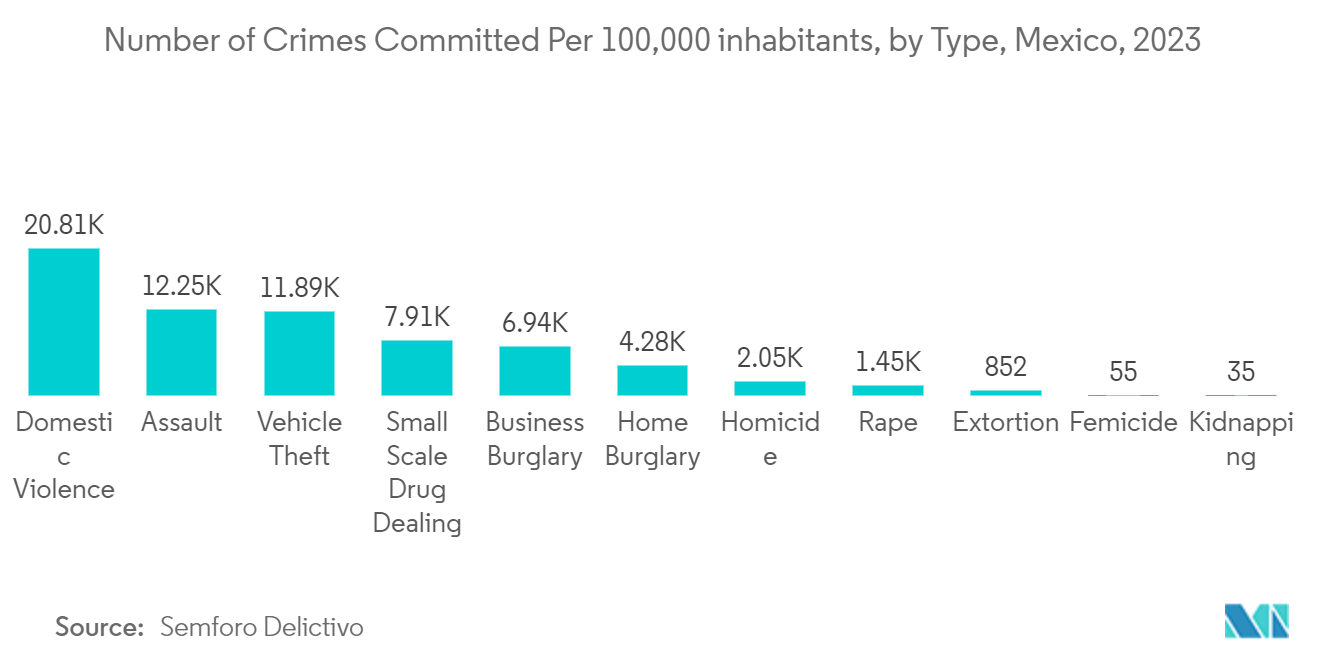
Brazil to Hold a Significant Market Share
- Brazil is among the largest and most economically established countries in Latin America. The urbanization rate in the country is also among the highest. For instance, according to the World Bank, the percentage of Brazil's urban population reached 87.56% in 2022. According to data from the Central Intelligence Agency (CIA), the urbanization rate in the country is anticipated to change by about 2.47% annually between 2020 and 2025. Suggesting a notable growth in urban population will drive the demand for more security and surveillance systems in the country.
- In recent years, several initiatives have been taken in the country regarding the adoption of surveillance cameras, creating a favorable market growth ecosystem. For instance, in 2023, Sao Paulo, the financial capital of Brazil, announced their plans to install about 20,000 cameras featuring facial recognition technology to enhance public safety.
- Similarly, in 2023, authorities in Rio de Janeiro announced their plans to purchase security cameras with facial recognition features, alarm sensors, and number plate readers to implement a citywide video surveillance system. In the first phase, these cameras will be installed in tunnels, motorways, and waterfronts, wherein all newly installed cameras will be connected to a security management system installed at the Integrated Command and Control Center (ICCC).
- Also, the rising crime rates are driving the adoption of surveillance cameras in Brazil. For instance, according to Consejo Ciudadano para la Seguridad Pública y la Justicia Penal, in 2023, Feira De Santana was the city with the highest homicide rate in Brazil (58.69) per 100,000 inhabitants, followed by Manaus (47.16) and Salvador (44.56).
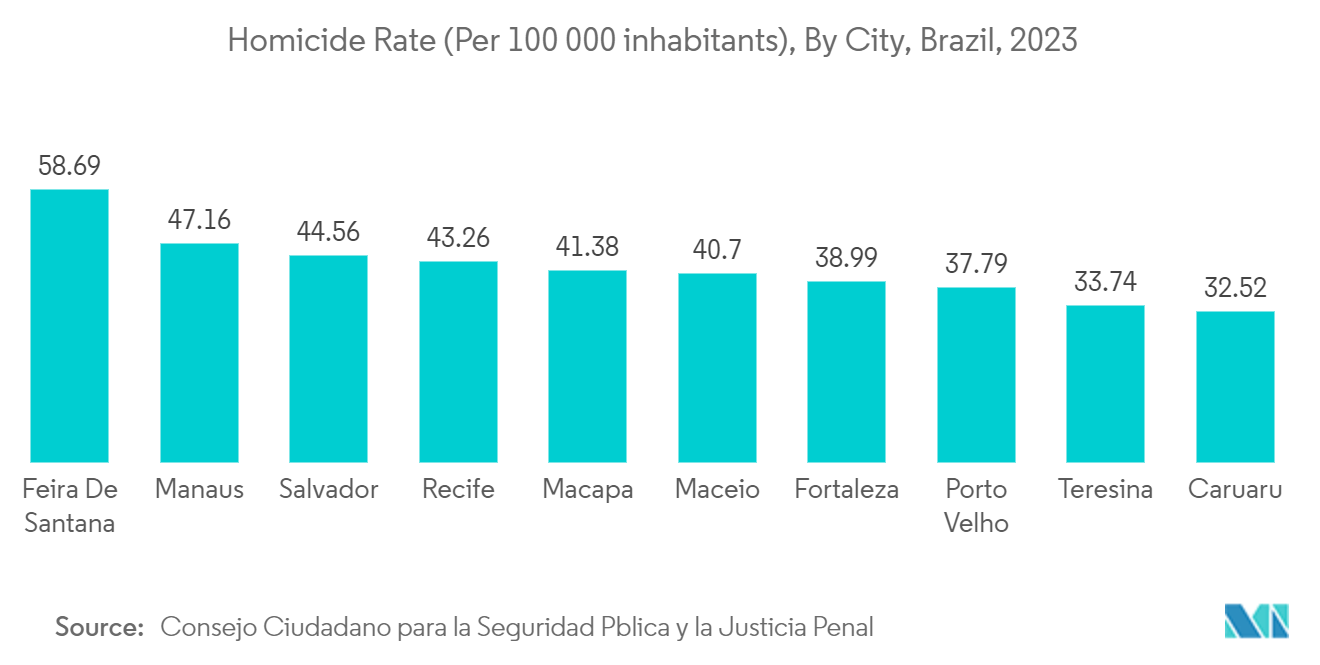
Latin America Video Surveillance Industry Overview
The Latin American video surveillance market is competitive due to several vendors' presence. The growing demand further attracts more vendors to the market, intensifying the competition. Vendors are adopting various strategies to strengthen their market presence further, including new product development, mergers, and acquisitions. Some key market players include Eagle Eye Networks, Honeywell Security Group, Teledyne FLIR, and Hikvision.
March 2024: Bitel, a major telecom company in Peru, invested USD 70,000 in a smart city project involving facial recognition in the District Municipality of Salaverry. According to the company, this surveillance initiative aims to integrate biometric technology into the existing urban infrastructure to improve residents' quality of life, streamline urban services, and reduce crime rates. Also, the company plans to deploy security cameras and smart devices throughout the district to monitor public spaces in real time.
January 2024: Hikvision, a leading provider of video surveillance systems, inaugurated a new office in Colombia. According to the company, the new facilities are located in Cali. The company aims to strengthen its presence in the country's southwest.
Latin America Video Surveillance Market Leaders
-
Eagle Eye Networks
-
Honeywell Security Group
-
Teledyne Flir LLC
-
Hangzhou Hikvision Digital Technology Company Limited
-
BOSCH Security Systems
*Disclaimer: Major Players sorted in no particular order
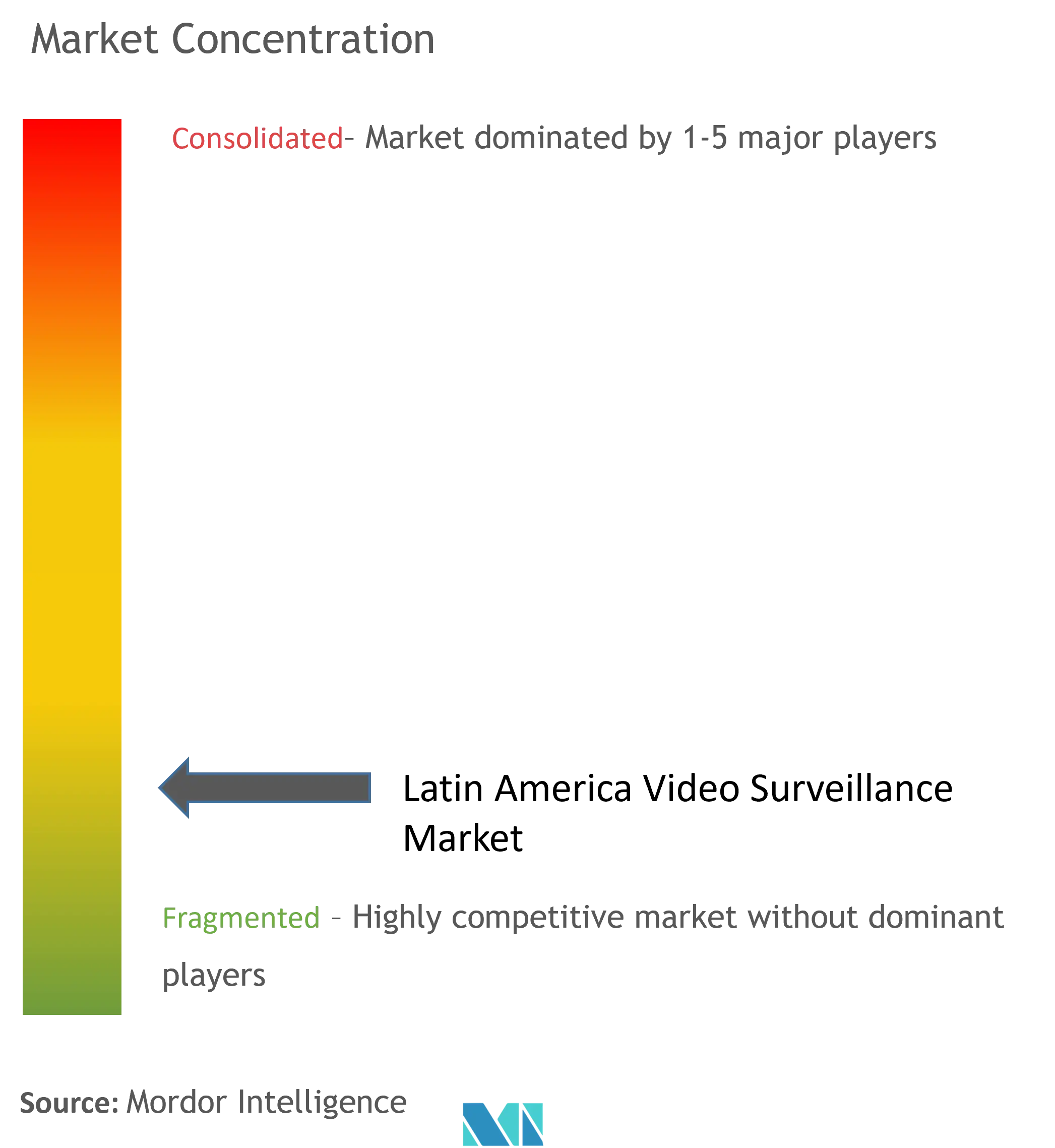
Latin America Video Surveillance Market News
- January 2024: A new video management software was implemented in San Miguel de Tucumán to manage Argentina's modern video surveillance system. The newly implemented Axxon One VMS platform allows 911 center personnel to autonomously manage cameras with advanced functionalities such as face detection, license plate recognition, infrared rays, video walls, and other resources that increase real-time monitoring efficiency.
- October 2023: New surveillance system comprising MIC IP ultra 7100i cameras of Bosch was installed at the port of Paracas in Peru. The newly installed camera system features 12x zoom and optical image stabilization (OIS). Also, features such as mobile pan, tilt, and zoom (PTZ) devices give the cameras excellent coverage of large areas.
Latin America Video Surveillance Market Report - Table of Contents
1. INTRODUCTION
- 1.1 Study Assumptions and Market Definition
- 1.2 Scope of the Study
2. RESEARCH METHODOLOGY
3. EXECUTIVE SUMMARY
4. MARKET INSIGHTS
- 4.1 Market Overview
-
4.2 Industry Attractiveness - Porter's Five Force Analysis
- 4.2.1 Bargaining Power of Suppliers
- 4.2.2 Bargaining Power of Buyers
- 4.2.3 Threat of New Entrants
- 4.2.4 Threat of Substitute Products
- 4.2.5 Intensity of Competitive Rivalry
- 4.3 Industry Value Chain Analysis
- 4.4 Technology Snapshot
- 4.5 Impact of Macroeconomic Trends On the Market
5. MARKET DYNAMICS
-
5.1 Market Drivers
- 5.1.1 Government Initiative to Enhance the Adoption of Advanced Security & Surveillance Solutions
- 5.1.2 Technological Innovation in Video Surveillance Systems/Solutions
-
5.2 Market Restraints
- 5.2.1 Privacy and Security Concerns
6. MARKET SEGMENTATION
-
6.1 By Type
- 6.1.1 Hardware
- 6.1.1.1 Camera
- 6.1.1.1.1 Analog
- 6.1.1.1.2 IP Cameras
- 6.1.1.1.3 Hybrid
- 6.1.1.2 Storage
- 6.1.2 Software
- 6.1.2.1 Video Analytics
- 6.1.2.2 Video Management Software
- 6.1.3 Services (VSaaS)
-
6.2 End-user Vertical
- 6.2.1 Commercial
- 6.2.2 Infrastructure
- 6.2.3 Institutional
- 6.2.4 Industrial
- 6.2.5 Defense
- 6.2.6 Residential
-
6.3 By Country
- 6.3.1 Brazil
- 6.3.2 Mexico
- 6.3.3 Argentina
- 6.3.4 Rest of Latin America
7. COMPETITIVE LANDSCAPE
-
7.1 Company Profiles
- 7.1.1 Honeywell Security Group
- 7.1.2 Panasonic System Networks Co. Ltd
- 7.1.3 Eagle Eye Networks
- 7.1.4 Vivotek Inc.
- 7.1.5 Hangzhou Hikvision Digital Technology Company Limited
- 7.1.6 Dahua Technology
- 7.1.7 Teledyne Flir LLC
- 7.1.8 BOSCH Security Systems
- 7.1.9 Verkada Inc.
- 7.1.10 Motorola Solutions Inc.
- 7.1.11 Infinova Group
- 7.1.12 Johnson Controls
- *List Not Exhaustive
8. INVESTMENT ANALYSIS
9. FUTURE OUTLOOK OF THE MARKET
** Subject To AvailablityLatin America Video Surveillance Industry Segmentation
Video surveillance systems leverage cameras or networks of camera systems and related hardware to capture footage in specific areas for live viewing or recording for later review. These systems transmit footage from cameras to centralized monitoring devices, servers, or cloud storage for future access or analysis.
The Latin American video surveillance market is segmented by type and end-user vertical. By type, the market is segmented by hardware, software, and services; the hardware segment is further segmented into camera and storage. The cameras segment is further subsegmented into analog, IP cameras, and hybrid. By software, the market is segmented into video analytics and video management software. By End-user vertical, the market is segmented into commercial, infrastructure, institutional, industrial, defense, and residential. By country, the market is segmented into Brazil, Mexico, Argentina, and the Rest of Latin America. The market sizes and forecasts are provided in terms of value (USD) for all the above segments.
| By Type | Hardware | Camera | Analog |
| IP Cameras | |||
| Hybrid | |||
| By Type | Hardware | Storage | |
| By Type | Software | Video Analytics | |
| Video Management Software | |||
| By Type | Services (VSaaS) | ||
| End-user Vertical | Commercial | ||
| Infrastructure | |||
| Institutional | |||
| Industrial | |||
| Defense | |||
| Residential | |||
| By Country | Brazil | ||
| Mexico | |||
| Argentina | |||
| Rest of Latin America |
Latin America Video Surveillance Market Research FAQs
How big is the Latin America Video Surveillance Market?
The Latin America Video Surveillance Market size is expected to reach USD 3.87 billion in 2024 and grow at a CAGR of 5.5% to reach USD 5.06 billion by 2029.
What is the current Latin America Video Surveillance Market size?
In 2024, the Latin America Video Surveillance Market size is expected to reach USD 3.87 billion.
Who are the key players in Latin America Video Surveillance Market?
Eagle Eye Networks, Honeywell Security Group, Teledyne Flir LLC, Hangzhou Hikvision Digital Technology Company Limited and BOSCH Security Systems are the major companies operating in the Latin America Video Surveillance Market.
What years does this Latin America Video Surveillance Market cover, and what was the market size in 2023?
In 2023, the Latin America Video Surveillance Market size was estimated at USD 3.66 billion. The report covers the Latin America Video Surveillance Market historical market size for years: 2019, 2020, 2021, 2022 and 2023. The report also forecasts the Latin America Video Surveillance Market size for years: 2024, 2025, 2026, 2027, 2028 and 2029.
Latin America Video Surveillance Industry Report
Statistics for the 2024 Latin America Video Surveillance market share, size and revenue growth rate, created by Mordor Intelligence™ Industry Reports. Latin America Video Surveillance analysis includes a market forecast outlook for 2024 to 2029 and historical overview. Get a sample of this industry analysis as a free report PDF download.



